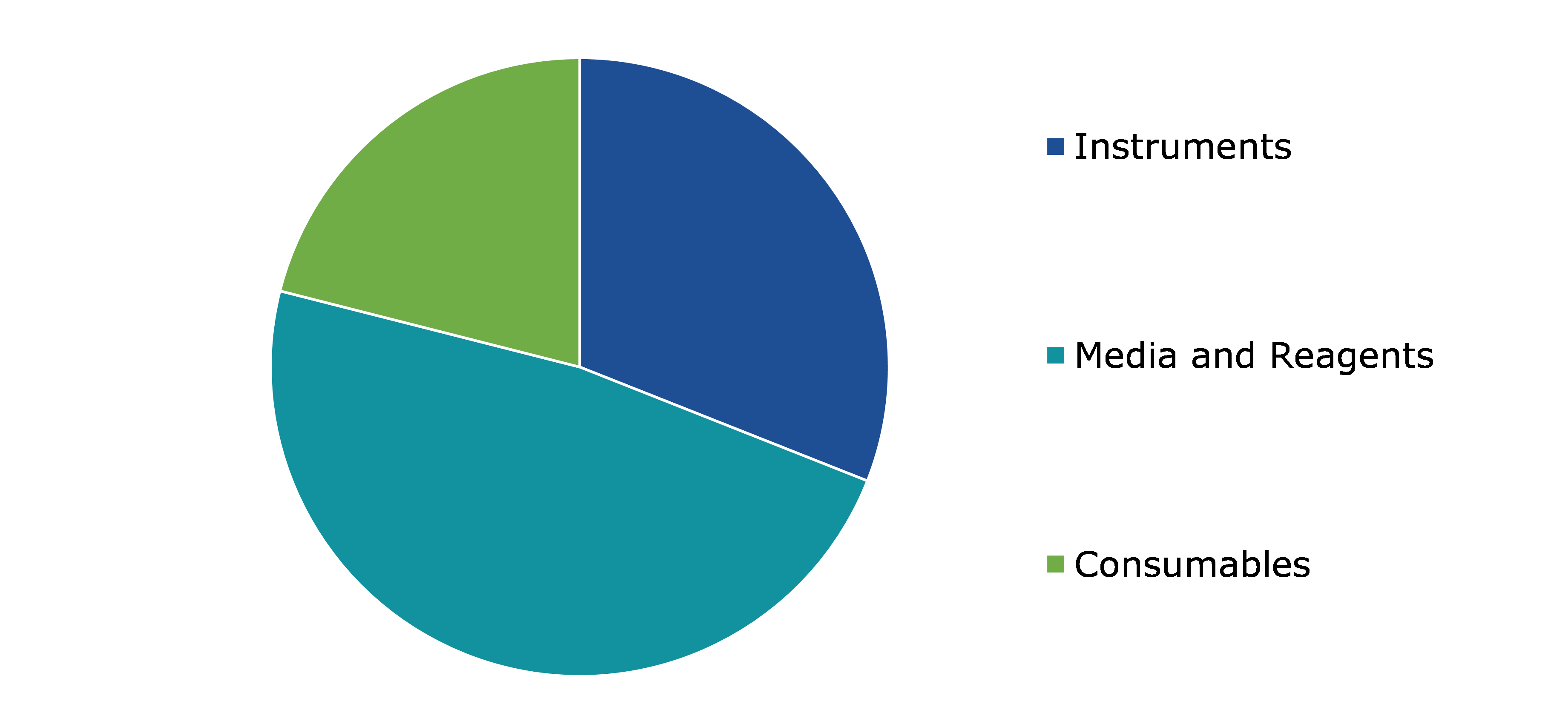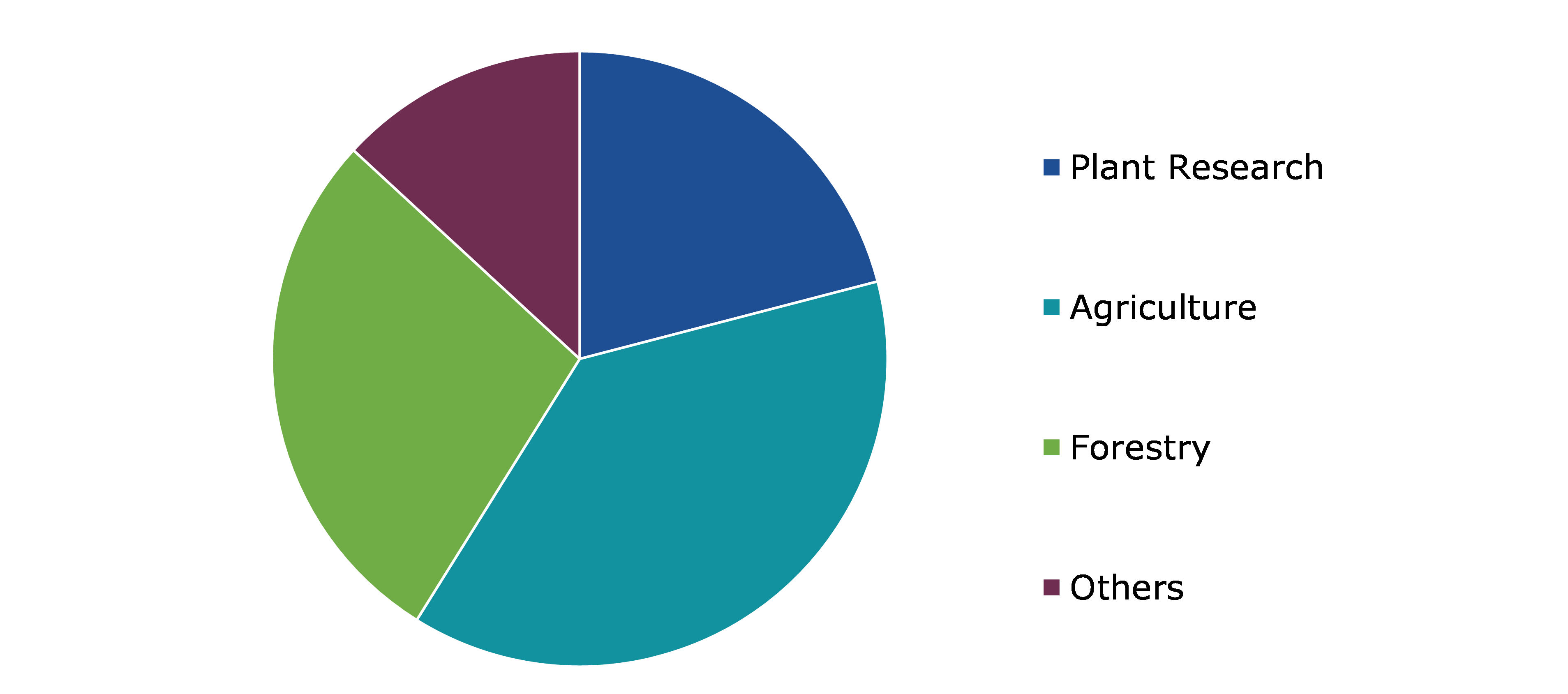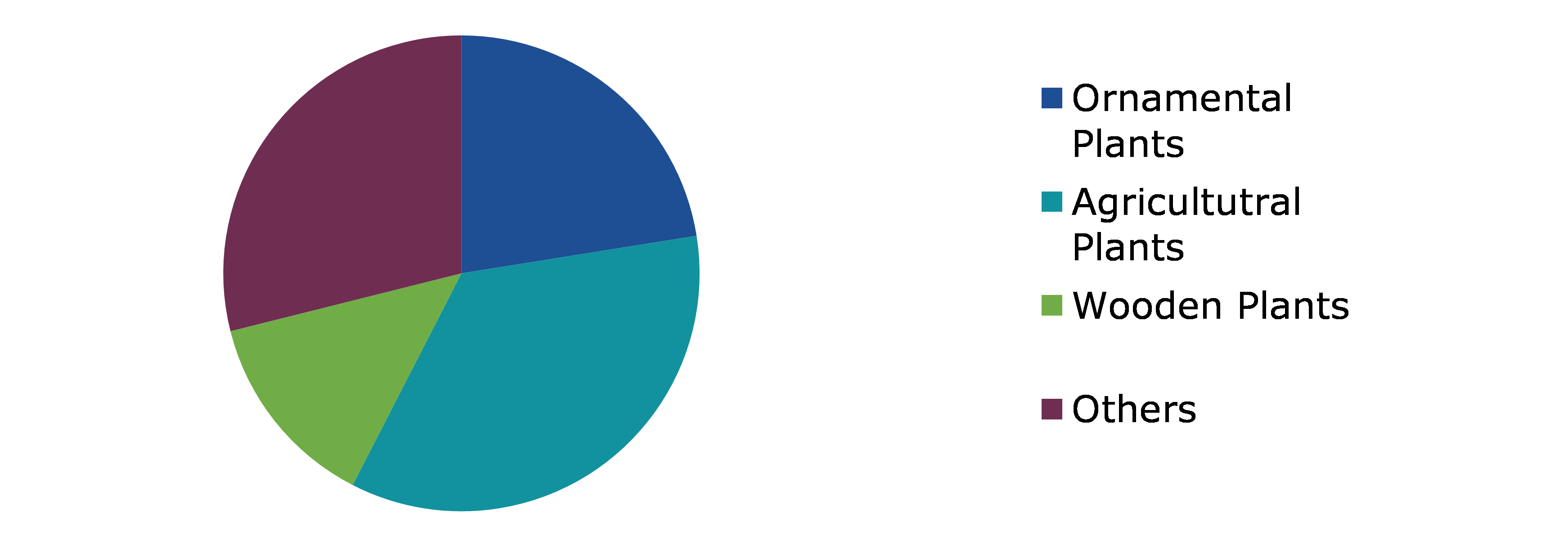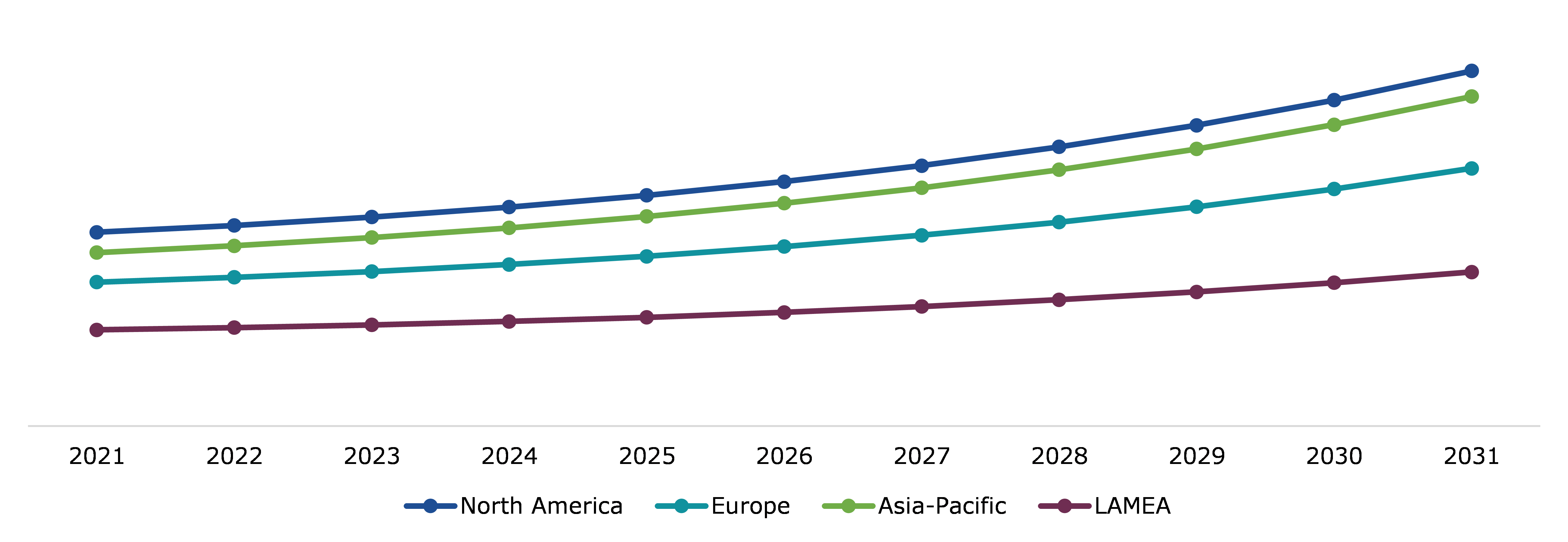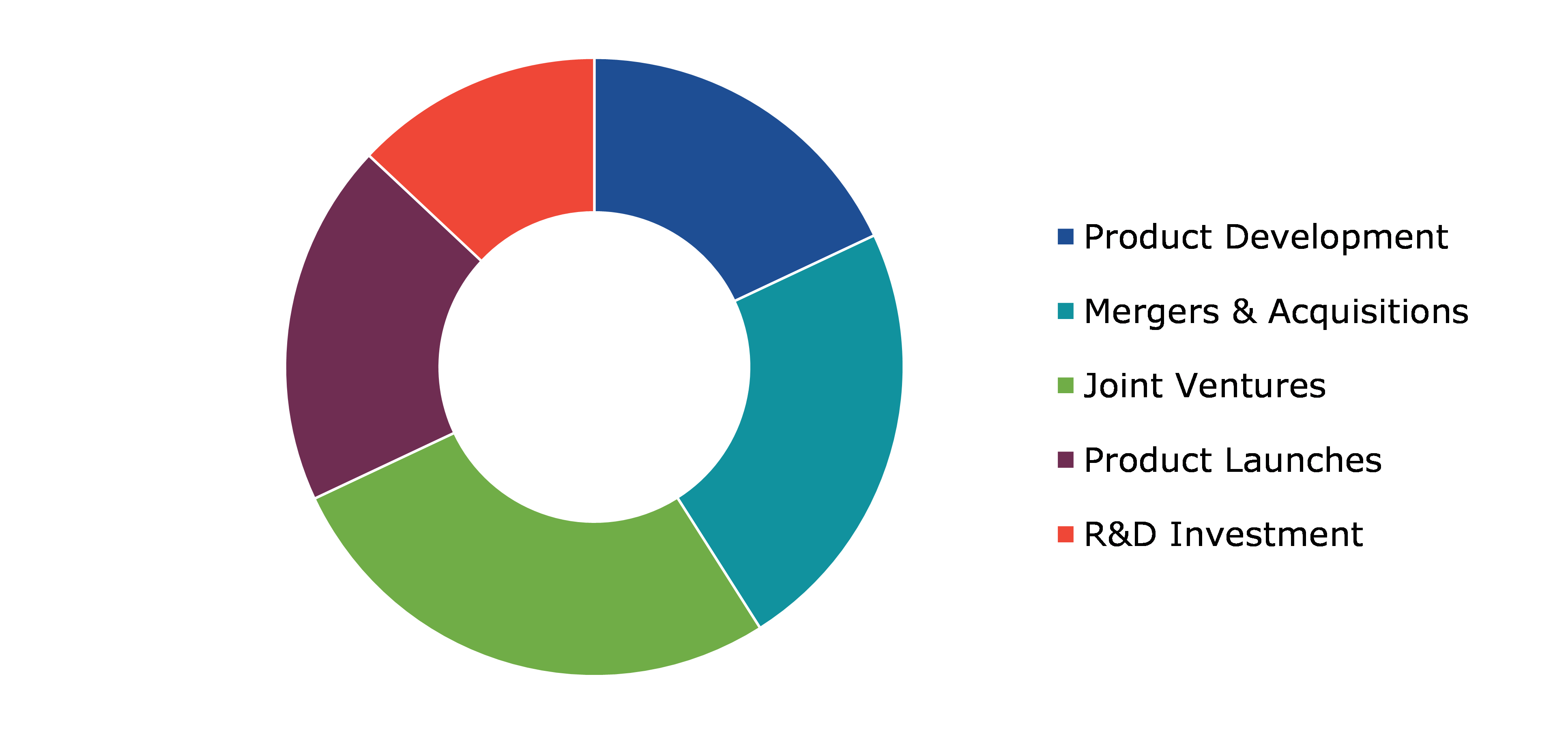Plant Tissue Culture Market Report
RA08609
Plant Tissue Culture Market by Type (Instruments, Media & Reagents, and Consumables), Application (Plant Research, Agriculture, Forestry, Appliances, and Others), Crop Type (Ornamental Plants, Agricultural Plants, Wooden Plants, and Others), and Regional Analysis (North America, Europe, Asia-Pacific, and LAMEA): Global Opportunity Analysis and Industry Forecast, 2022-2031
Global Plant Tissue Culture Market Analysis
The Global Plant Tissue Culture Market Size was $1,220 million in 2021 and is predicted to grow with a CAGR of 6.4%, by generating a revenue of $2,202.9 million by 2031.
Global Plant Tissue Culture Market Synopsis
The increase in government support has led to an increase in the number of plant tissue culture labs and has created new opportunities for businesses in the market. It has also created a favorable environment for the growth of the market as more farmers are adopting tissue culture techniques to produce high-quality, disease-free plants. Moreover, the government's efforts to promote sustainable agriculture and increase food production have also boosted the growth of the plant tissue market. They are promoting the use of tissue culture techniques to produce genetically superior plants that are resistant to diseases and pests, which results in higher yields and improved food security. Government support for the agriculture sector is a key driver of the plant tissue culture market.
However, the lack of standardization in the production process and quality control can also contribute to the high cost of production, as it requires frequent monitoring and testing. This can also lead to variations in the quality of the products available in the market, affecting consumer confidence and demand. The high cost of production is a major limitation in the growth and development of the plant tissue culture market, limiting its accessibility and affordability for the general public. Efforts to reduce the cost of production, improve standardization and quality control, and increase public awareness and education about the benefits of plant tissue culture products are essential to overcome this limitation.
The use of plant tissue culture techniques for the production of plant-based food products is becoming increasingly popular as it allows for the creation of high-quality, genetically uniform crops that are free from pests and diseases. This results in higher yields and more consistent quality, making these products more appealing to consumers. Moreover, the use of plant tissue culture techniques can also help to reduce the use of pesticides and fertilizers, making these products more environmentally friendly. This is becoming a key selling point for consumers who are becoming more conscious about their impact on the environment. The growing demand for plant-based food products, coupled with advancements in technology and techniques, is expected to drive significant growth in the plant tissue market in the coming years.
According to regional analysis, the Asia-Pacific plant tissue culture market is anticipated to be the fastest growing in 2031. The Asia Pacific region is a significant market for plant tissue culture and is expected to grow rapidly due to increasing demand for horticultural products, favorable government policies, and the growing use of tissue culture in agriculture. Countries such as China, India, Japan, and Australia are some of the major contributors to the growth of the plant tissue culture market in the Asia Pacific region.
Plant Tissue Culture Overview
Plant tissue culture is the sterile and carefully controlled cultivation of plant seeds, organs, explants, tissues, cells, or protoplasts on a chemically defined synthetic nutritional medium. This market is growing due to the increasing demand for food, feed, fuel, and fiber, as well as the increasing focus on developing new plant-based products, such as biodegradable plastics and biofuels.
COVID-19 Impact on Global Plant Tissue Culture Market
The COVID-19 pandemic has had a significant impact on the plant tissue culture market, both positively and negatively. On one hand, the global pandemic has led to an increase in demand for plant-based food products as people become more conscious about their health and the environment. This has led to an increase in the demand for plant tissue culture techniques as a means of producing high-quality, genetically uniform crops. On the other hand, the pandemic has led to supply chain disruptions and delays in production and distribution, which has affected the market negatively. The shortage of labor and raw materials, along with the closure of production facilities, has disrupted the production and distribution of plant-based food products, leading to shortages and price hikes.
Growing Demand for Food and Biofuel Sector to Drive the Market Growth
The increase in demand for food and biofuels with the growing global population is because plant tissue culture is a method of growing plants in a controlled environment, which allows for faster and more efficient plant growth and production. This method can be used to grow crops that are in high demand, such as fruits and vegetables, as well as crops that are used for biofuels, such as corn, sugarcane, and algae. Moreover, plant tissue culture also allows for the production of genetically modified crops that are more resistant to pests and diseases, have higher yields, and are more nutritious. This, in turn, increases the productivity of agriculture and contributes to meeting the growing demand for food and biofuels. The increase in demand for food and biofuels is a major driving factor for the growth of the plant tissue culture market. The COVID-19 pandemic has had a mixed impact on the plant tissue culture market. While there has been an increase in demand for plant-based food products, supply chain disruptions and delays in production and research have negatively impacted the market.
To know more about global plant tissue culture market drivers, get in touch with our analysts here.
Limited Production Capacity Over The Plant Tissue Culture to Restrain the Market Growth
The major challenge for the plant tissue market affects the overall demand and supply dynamics. The limited production capacity results in the lower availability of high-quality plant tissue culture products, which affects the growth of the market. The shortage of plant tissue culture products often results in higher prices, making it difficult for farmers and growers to access these products. In some cases, it also leads to the import of lower-quality products, which affects the quality and success rate of the plants grown using these products, which is anticipated to hamper the plant tissue culture market growth.
Increasing Demand For Organic and Non-GMO Products To Drive Excellent Opportunities
As consumers become more aware of the potential health risks associated with genetically modified organisms (GMOs) and chemically-treated crops, they are seeking out more natural, organic options. This shift in consumer preferences has led to an increased demand for plant tissue-based products that are organic, non-GMO, and free of harmful chemicals. This growth is due to several factors, including the increasing awareness of the health benefits of organic and non-GMO products, rising demand for food and beverages made from organic ingredients, and the growing popularity of organic and sustainable farming practices. The organic and non-GMO plant tissue market is expected to grow significantly in the coming years.
To know more about global plant tissue culture market opportunities, get in touch with our analysts here.
Global Plant Tissue Culture Market, by Type
On the basis of type, the market has been divided into instruments, media & reagents, and consumables. Among these, the media & reagents segment accounted for the highest market share in 2021 as well as is estimated to show the fastest growth during the forecast period.
Global Plant Tissue Culture Market Size, by Type, 2021
Source: Research Dive Analysis
The media & reagents segment accounted for a dominant market share in 2021. Plant tissue culture media provides a balanced mixture of essential nutrients, hormones, and growth factors that are essential for plant tissue growth and development. The media and reagents play a crucial role in the plant tissue culture market by providing essential nutrients and growth factors for the growth and development of plant tissues and helping to reduce the cost of production.
Global Plant Tissue Culture Market, by Application
On the basis of application, the market has been divided into plant research, agriculture, forestry, appliances, and others. Among these, the agriculture segment accounted for the highest revenue share in 2021.
Global Plant Tissue Culture Market Share, by Application, 2021
Source: Research Dive Analysis
The agriculture segment accounted for a dominant market share in 2021. The growth can be attributed to the increasing demand for high-quality and genetically uniform crops, as well as the need to preserve plant genetic diversity. Plant tissue culture techniques have been widely adopted in agriculture to produce large numbers of genetically uniform plants, which can be used for commercial purposes. This results in increased yields and improved quality crops, making it a crucial tool for farmers looking to maximize their profits.
Global Plant Tissue Culture Market, by Crop Type
Based on crop type, the market has been divided into ornamental plants, agricultural plants, wooden plants, and others. Among these, the agricultural plants segment accounted for the highest revenue share in 2021.
Global Plant Tissue Culture Market Statistics, by Crop Type, 2021
Source: Research Dive Analysis
The agricultural plants segment accounted for a dominant market share in 2021. Plant tissue culture is also used for genetic research, as it provides a means to study the genetic makeup and growth patterns of plants. This information can then be used to improve the quality and yield of crops, increase resistance to pests and diseases, and enhance environmental tolerance. The plant tissue culture plays a crucial role in agriculture and horticulture, providing a means to produce high-quality, disease-free plants for commercial use, as well as for research and development purposes.
Global Plant Tissue Culture Market, Regional Insights
The plant tissue culture market was investigated across North America, Europe, Asia-Pacific, and LAMEA.
Global Plant Tissue Culture Market Size & Forecast, by Region, 2021-2031 (USD Million)
Source: Research Dive Analysis
The Market for Plant Tissue Culture in Asia-Pacific to be the Most Dominant
The Asia Pacific region is the fastest-growing market for plant tissue culture. This growth is driven by several factors, including the increasing demand for food and the growing demand for high-quality ornamental plants. The increasing population, rising income levels, and urbanization in the region have created a huge demand for food and ornamental plants. Furthermore, the Asia Pacific region is also home to some of the world's largest plant tissue culture laboratories, including China, India, and South Korea. These countries have a strong agricultural sector and a rapidly growing biotechnology industry, which have led to the development of advanced plant tissue culture techniques and technologies. The Asia Pacific region is expected to continue its growth trajectory in the plant tissue culture market, driven by increasing demand for food, ornamental plants, and the growing biotechnology industry.
Competitive Scenario in the Global Plant Tissue Culture Market
Investment and agreement are common strategies followed by major market players. For instance, in August 2021, Vita Farms and ForemostCo collaborated to establish Vita Labs, a new culturing lab in Guatemala, to address the need for artificial tissue culture medium. The new factory was built in response to an increase in worldwide market demand for clean, healthy starting materials.
Source: Research Dive Analysis
Some of the leading plant tissue culture market players are Alpha Laboratories, Agriforest Bio-Technologies, Booms Pharm, Caisson Laboratories, Inc., Australis Capital Inc., Labland Biotech Private Limited, Phytotech Laboratories, Inc., Phytoclone Inc., Rubi Bio LLC, and Merck KGaA.
| Aspect | Particulars |
| Historical Market Estimations | 2020 |
| Base Year for Market Estimation | 2021 |
| Forecast Timeline for Market Projection | 2022-2031 |
| Geographical Scope | North America, Europe, Asia-Pacific, and LAMEA |
| Segmentation by Type |
|
| Segmentation by Application |
|
| Segmentation by Crop Type
|
|
| Key Companies Profiled |
|
Q1. What is the size of the global plant tissue culture market?
A. The size of the global plant tissue culture market was over $1,220 million in 2021 and is projected to reach $2,202.9 million by 2031.
Q2. Which are the major companies in the plant tissue culture market?
A. Alpha Laboratories, Agriforest Bio-Technologies, and Booms Pharm are some of the key players in the global plant tissue culture market.
Q3. Which region, among others, possesses greater investment opportunities in the near future?
A. Asia-Pacific possesses great investment opportunities for investors to witness the most promising growth in the future.
Q4. What will be the growth rate of the Asia-Pacific plant tissue culture market?
A. Asia-Pacific plant tissue culture market is anticipated to grow at 6.9% CAGR during the forecast period.
Q5. What are the strategies opted by the leading players in the market?
A. Agreement and investment are the two key strategies opted by the operating companies in the market.
Q6. Which companies are investing more on R&D practices?
A. Caisson Laboratories, Inc, Australis Capital Inc, and Labland Biotech Private Limited are the companies investing more on R&D activities for developing new products and technologies.
1.Research Methodology
1.1.Desk Research
1.2.Real time insights and validation
1.3.Forecast model
1.4.Assumptions and forecast parameters
1.5.Market size estimation
1.5.1.Top-down approach
1.5.2.Bottom-up approach
2.Report Scope
2.1.Market definition
2.2.Key objectives of the study
2.3.Report overview
2.4.Market segmentation
2.5.Overview of the impact of COVID-19 on Global plant tissue culture market
3.Executive Summary
4.Market Overview
4.1.Introduction
4.2.Growth impact forces
4.2.1.Drivers
4.2.2.Restraints
4.2.3.Opportunities
4.3.Market value chain analysis
4.3.1.List of raw material suppliers
4.3.2.List of manufacturers
4.3.3.List of distributors
4.4.Innovation & sustainability matrices
4.4.1.Technology matrix
4.4.2.Regulatory matrix
4.5.Porter’s five forces analysis
4.5.1.Bargaining power of suppliers
4.5.2.Bargaining power of consumers
4.5.3.Threat of substitutes
4.5.4.Threat of new entrants
4.5.5.Competitive rivalry intensity
4.6.PESTLE analysis
4.6.1.Political
4.6.2.Economical
4.6.3.Social
4.6.4.Technological
4.6.5.Environmental
4.7.Impact of COVID-19 on Plant Tissue Culture market
4.7.1.Pre-covid market scenario
4.7.2.Post-covid market scenario
5.Plant Tissue Culture Market Analysis, by Type
5.1.Overview
5.2.Instruments
5.2.1.Definition, key trends, growth factors, and opportunities
5.2.2.Market size analysis, by region
5.2.3.Market share analysis, by country
5.3.Media and Reagents
5.3.1.Definition, key trends, growth factors, and opportunities
5.3.2.Market size analysis, by region
5.3.3.Market share analysis, by country
5.4.Consumables
5.4.1.Definition, key trends, growth factors, and opportunities
5.4.2.Market size analysis, by region
5.4.3.Market share analysis, by country
5.5.Research Dive Exclusive Insights
5.5.1.Market attractiveness
5.5.2.Competition heatmap
6.Plant Tissue Culture Market Analysis, by Application
6.1.Plant Research
6.1.1.Definition, key trends, growth factors, and opportunities
6.1.2.Market size analysis, by region
6.1.3.Market share analysis, by country
6.2.Agriculture
6.2.1.Definition, key trends, growth factors, and opportunities
6.2.2.Market size analysis, by region
6.2.3.Market share analysis, by country
6.3.Forestry
6.3.1.Definition, key trends, growth factors, and opportunities
6.3.2.Market size analysis, by region
6.3.3.Market share analysis, by country
6.4.Others
6.4.1.Definition, key trends, growth factors, and opportunities
6.4.2.Market size analysis, by region
6.4.3.Market share analysis, by country
6.5.Research Dive Exclusive Insights
6.5.1.Market attractiveness
6.5.2.Competition heatmap
7.Plant Tissue Culture Market Analysis, by Crop Type
7.1.Ornamental Plants
7.1.1.Definition, key trends, growth factors, and opportunities
7.1.2.Market size analysis, by region
7.1.3.Market share analysis, by country
7.2.Agricultural Plants
7.2.1.Definition, key trends, growth factors, and opportunities
7.2.2.Market size analysis, by region
7.2.3.Market share analysis, by country
7.3.Wooden Plants
7.3.1.Definition, key trends, growth factors, and opportunities
7.3.2.Market size analysis, by region
7.3.3.Market share analysis, by country
7.4.Others
7.4.1.Definition, key trends, growth factors, and opportunities
7.4.2.Market size analysis, by region
7.4.3.Market share analysis, by country
7.5.Research Dive Exclusive Insights
7.5.1.Market attractiveness
7.5.2.Competition heatmap
8.Plant Tissue Culture Market, by Region
8.1.North America
8.1.1.U.S.
8.1.1.1.Market size analysis, by Type
8.1.1.2.Market size analysis, by Application
8.1.1.3.Market size analysis, by Crop Type
8.1.2.Canada
8.1.2.1.Market size analysis, by Type
8.1.2.2.Market size analysis, by Application
8.1.2.3.Market size analysis, by Crop Type
8.1.3.Mexico
8.1.3.1.Market size analysis, by Type
8.1.3.2.Market size analysis, by Application
8.1.3.3.Market size analysis, by Crop Type
8.1.4.Research Dive Exclusive Insights
8.1.4.1.Market attractiveness
8.1.4.2.Competition heatmap
8.2.Europe
8.2.1.Germany
8.2.1.1.Market size analysis, by Type
8.2.1.2.Market size analysis, by Application
8.2.1.3.Market size analysis, by Crop Type
8.2.2.UK
8.2.2.1.Market size analysis, by Type
8.2.2.2.Market size analysis, by Application
8.2.2.3.Market size analysis, by Crop Type
8.2.3.France
8.2.3.1.Market size analysis, by Type
8.2.3.2.Market size analysis, by Application
8.2.3.3.Market size analysis, by Crop Type
8.2.4.Spain
8.2.4.1.Market size analysis, by Type
8.2.4.2.Market size analysis, by Application
8.2.4.3.Market size analysis, by Crop Type
8.2.5.Italy
8.2.5.1.Market size analysis, by Type
8.2.5.2.Market size analysis, by Application
8.2.5.3.Market size analysis, by Crop Type
8.2.6.Rest of Europe
8.2.6.1.Market size analysis, by Type
8.2.6.2.Market size analysis, by Application
8.2.6.3.Market size analysis, by Crop Type
8.2.7.Research Dive Exclusive Insights
8.2.7.1.Market attractiveness
8.2.7.2.Competition heatmap
8.3.Asia-Pacific
8.3.1.China
8.3.1.1.Market size analysis, by Type
8.3.1.2.Market size analysis, by Application
8.3.1.3.Market size analysis, by Crop Type
8.3.2.Japan
8.3.2.1.Market size analysis, by Type
8.3.2.2.Market size analysis, by Application
8.3.2.3.Market size analysis, by Crop Type
8.3.3.India
8.3.3.1.Market size analysis, by Type
8.3.3.2.Market size analysis, by Application
8.3.3.3.Market size analysis, by Crop Type
8.3.4.Australia
8.3.4.1.Market size analysis, by Type
8.3.4.2.Market size analysis, by Application
8.3.4.3.Market size analysis, by Crop Type
8.3.5.South Korea
8.3.5.1.Market size analysis, by Type
8.3.5.2.Market size analysis, by Application
8.3.5.3.Market size analysis, by Crop Type
8.3.6.Rest of Asia-Pacific
8.3.6.1.Market size analysis, by Type
8.3.6.2.Market size analysis, by Application
8.3.6.3.Market size analysis, by Crop Type
8.3.7.Research Dive Exclusive Insights
8.3.7.1.Market attractiveness
8.3.7.2.Competition heatmap
8.4.LAMEA
8.4.1.Brazil
8.4.1.1.Market size analysis, by Type
8.4.1.2.Market size analysis, by Application
8.4.1.3.Market size analysis, by Crop Type
8.4.2.Saudi Arabia
8.4.2.1.Market size analysis, by Type
8.4.2.2.Market size analysis, by Application
8.4.2.3.Market size analysis, by Crop Type
8.4.3.UAE
8.4.3.1.Market size analysis, by Type
8.4.3.2.Market size analysis, by Application
8.4.3.3.Market size analysis, by Crop Type
8.4.4.South Africa
8.4.4.1.Market size analysis, by Type
8.4.4.2.Market size analysis, by Application
8.4.4.3.Market size analysis, by Crop Type
8.4.5.Rest of LAMEA
8.4.5.1.Market size analysis, by Type
8.4.5.2.Market size analysis, by Application
8.4.5.3.Market size analysis, by Crop Type
8.4.6.Research Dive Exclusive Insights
8.4.6.1.Market attractiveness
8.4.6.2.Competition heatmap
9.Competitive Landscape
9.1.Top winning strategies, 2021
9.1.1.By strategy
9.1.2.By year
9.2.Strategic overview
9.3.Market share analysis, 2021
10.Company Profiles
10.1.Alpha Laboratories
10.1.1.Overview
10.1.2.Business segments
10.1.3.Product portfolio
10.1.4.Financial performance
10.1.5.Recent developments
10.1.6.SWOT analysis
10.2.Agriforest Bio-Technologies
10.2.1.Overview
10.2.2.Business segments
10.2.3.Product portfolio
10.2.4.Financial performance
10.2.5.Recent developments
10.2.6.SWOT analysis
10.3.Booms Pharm
10.3.1.Overview
10.3.2.Business segments
10.3.3.Product portfolio
10.3.4.Financial performance
10.3.5.Recent developments
10.3.6.SWOT analysis
10.4.Caisson Laboratories, Inc
10.4.1.Overview
10.4.2.Business segments
10.4.3.Product portfolio
10.4.4.Financial performance
10.4.5.Recent developments
10.4.6.SWOT analysis
10.5.Australis Capital Inc.
10.5.1.Overview
10.5.2.Business segments
10.5.3.Product portfolio
10.5.4.Financial performance
10.5.5.Recent developments
10.5.6.SWOT analysis
10.6.Labland Biotech Private Limited
10.6.1.Overview
10.6.2.Business segments
10.6.3.Product portfolio
10.6.4.Financial performance
10.6.5.Recent developments
10.6.6.SWOT analysis
10.7.Phytotech Laboratories
10.7.1.Overview
10.7.2.Business segments
10.7.3.Product portfolio
10.7.4.Financial performance
10.7.5.Recent developments
10.7.6.SWOT analysis
10.8.Phytoclone Inc
10.8.1.Overview
10.8.2.Business segments
10.8.3.Product portfolio
10.8.4.Financial performance
10.8.5.Recent developments
10.8.6.SWOT analysis
10.9.Rubi Bio LLC
10.9.1.Overview
10.9.2.Business segments
10.9.3.Product portfolio
10.9.4.Financial performance
10.9.5.Recent developments
10.9.6.SWOT analysis
10.10.Merck KGaA
10.10.1.Overview
10.10.2.Business segments
10.10.3.Product portfolio
10.10.4.Financial performance
10.10.5.Recent developments
10.10.6.SWOT analysis
Plant tissue culture is a technique primarily used for growing of plant cells, tissues, and/or organs using a nutrient medium. These techniques are mainly used to produce plant clones which have desirable traits like disease resistance, good flowers, high quality seeds, etc. The time taken by this method for plant production is significantly less as compared to traditional plant growing techniques which has increased its popularity considerably. There are many types of plant tissue cultures such as seed culture, embryo culture, organ culture, etc.
Forecast Analysis of the Plant Tissue Culture Market
In recent years, there has been increase in the governmental support for plant tissue culture techniques which has led to a growth in the number of plant tissue culture labs. This growth is predicted to be the primary growth driver of the plant tissue culture market in the forecast period. Additionally, growing adoption of tissue culture techniques by farmers to produce high-quality, disease-free plants is anticipated to push the market forward. Along with this, increased governmental efforts to promote sustainable agriculture and increase food production is projected to offer numerous growth and investment opportunities to the market in the analysis timeframe. However, limited production capacity over plant tissue culture is estimated to create hurdles in the full-fledged growth of the plant tissue culture market in the coming period.
Regionally, the plant tissue culture market in the Asia-Pacific region is expected to be the most dominant by 2031. Growing demand for food and high-quality ornamental plants is expected to be the leading factor behind the growth of the market in this region.
According to the report published by Research Dive, the global plant tissue culture market is expected to gather a revenue of $2,202.9 million by 2031 and grow at 6.4% CAGR in the 2022–2031 timeframe. Some prominent market players include Alpha Laboratories, Australis Capital Inc., Phytoclone Inc., Agriforest Bio-Technologies, Labland Biotech Private Limited, Rubi Bio LLC, Booms Pharm, Phytotech Laboratories, Inc., Merck KGaA, Caisson Laboratories, Inc., and many others.
Covid-19 Impact on the Market
The outbreak of the Covid-19 pandemic has had a massive negative effect on almost all industries and businesses across the world. The plant tissue culture market, however, faced a moderate impact of the pandemic. The pandemic saw a huge demand from people across the globe for plant-based products to boost their immunity which led to growth in demand for plant tissue culture. One the other hand, however, disruptions in global supply chains hampered the production and distribution channels which negatively impacted the market growth.
Significant Market Developments
The significant companies operating in the industry are adopting numerous growth strategies & business tactics such as partnerships, collaborations, mergers & acquisitions, and launches to maintain a robust position in the overall market, thus helping the plant tissue culture market to flourish. For instance:
In August 2021, ForemostCo Inc., a leading plant nursery in the US, announced that it was partnering with Vita Farms, a leading plant cuttings provider in the US, Europe, and Canada. This partnership is aimed at establishing tissue culture labs in Guatemala in order to address the supply-demand mismatches and gaps. The partnership is anticipated to help both the companies to expand their footprint in the plant tissue culture market.
In March 2022, AgriFORCE Growing Systems, a leading agriculture technology company, announced the acquisition of Deroose Plants NV, a global leader in plant tissue culture techniques. This acquisition is predicted to help the acquiring company to place itself among the major market players of the industry in the next few years.
In May 2022, Segra International Corp, a leading cannabis agriculture technology company, announced that it was partnering with Compound Genetics, a leading cannabis brand. Under this partnership agreement, nursery stock plantlets grown using plant tissue culture will be distributed to cannabis cultivators globally. The partnership is thus, expected to help both the partners immensely in the coming period.
Personalize this research
- Triangulate with your own data
- Request your format and definition
- Get a deeper dive on a specific application, geography, customer or competitor
- + 1-888-961-4454 Toll - Free
- support@researchdive.com


